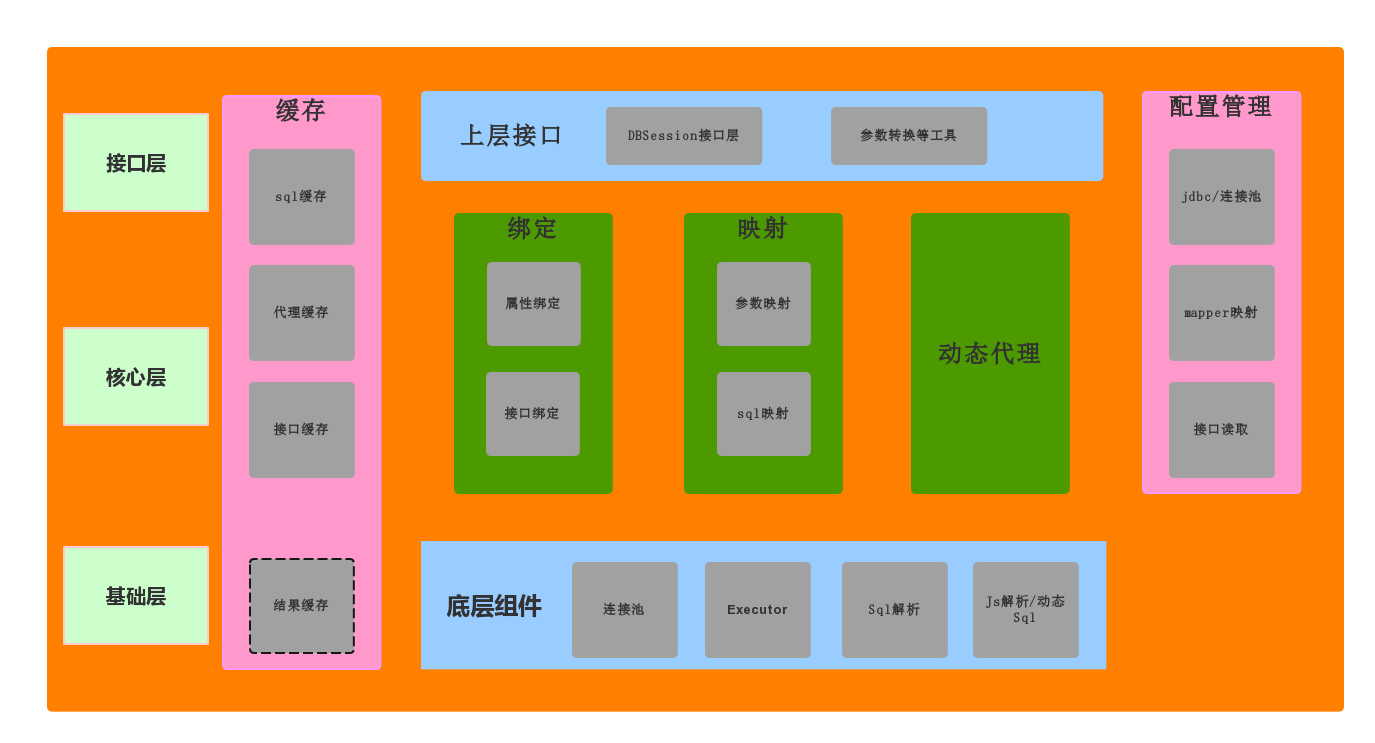slardar是一个sql mapping框架,其大概使用方式类似mybatis,没有采用hibernate那种orm的方式是因为个人觉得这种方式需要大量的处理sql,每次操作对象都要进行依次sql解析比较繁琐;转而想到mybatis这种把sql逻辑交给用户的方式还是比较合理的。同时又不像全盘照抄mybatis,还是想有一些独特的地方,于是将mybatis的xml配置sql的方式换成了javascript,通过解析javascript来得到sql,并能达到生成动态sql的功能,一举两得。
架构图如下:

虚线部分目前没有实现,目前版本的slardar暂时没有缓存sql执行结果。并且还没有实现缓存淘汰策略,这将是下一个版本要努力做的。
slardar的使用方法和mybatis十分类似,因为大体api的使用设计就是根据它来的。
一. 第一个例子
slardar的使用如下。 假设我们要做一个简单的查询:
首先创建一个和数据库表对应的实体,我们以一个用户表为例。
package org.easyarch.test.pojo;
import org.easyarch.slardar.annotation.entity.Column;
import org.easyarch.slardar.annotation.entity.Table;
@Table(tableName = "user")
public class User {
@Column(name = "client_id")
private String clientId;
@Column(name = "username")
private String userName;
@Column(name = "password")
private String password;
@Column(name = "phone")
private String phone;
public String getClientId() {
return clientId;
}
public void setClientId(String clientId) {
this.clientId = clientId == null ? null : clientId.trim();
}
public String getUserName() {
return userName;
}
public void setUserName(String userName) {
this.userName = userName;
}
public String getPassword() {
return password;
}
public void setPassword(String password) {
this.password = password == null ? null : password.trim();
}
public String getPhone() {
return phone;
}
public void setPhone(String phone) {
this.phone = phone == null ? null : phone.trim();
}
}
接下来,创建一个mapper接口,通过id对我们的用户表进行查询:
package org.easyarch.test.dao;
import org.easyarch.slardar.annotation.sql.SqlParam;
import org.easyarch.test.pojo.User;
import java.util.List;
public interface UserMapper {
public User findById(@SqlParam(name = "id") String id);
public List<User> findByUser(User user);
}
这里@SqlParam注解中的name将是后面sql模板中配置所需要的,接下来我们就可以创建相关的配置文件:
先创建一个 resources/db.properties 文件用来连接我们的数据库:
username = ****
password = ****
url = jdbc:mysql://localhost:3306/testdb?useUnicode=true&characterEncoding=utf8&useSSL=false
driverClassName = com.mysql.jdbc.Driver
maxActive =100
minIdle = 10
initialSize = 40
maxWait = 6000
接下来配置slardar所需的信息,新建一个 resources/config.xml:
<configuration>
<interface package="org.easyarch.test.dao" />
<mapper location="classpath:mapper/" />
<datasource location="classpath:db.properties" class=""/>
</configuration>
然后我们编写一个js文件,mapper/usermapper.js 这样:
ctx.namespace = "org.easyarch.test.dao.UserMapper";
function findById(params){
return "select * from user where client_id = $id$";
}
function findByUser(params) {
var sql = "select * from user" + ctx.where;
if (params.clientId != undefined){
sql += " and client_id = $clientId$";
}
if (params.phone != undefined){
sql += " and phone = $phone$";
}
return sql;
}
ctx.namespace是UserMapper接口名, js方法必须和对应接口方法名同名(参数就不用管了)
然后我们写一个Service类,来初始化操作:
package org.easyarch.test.service;
import org.easyarch.slardar.entity.Parameter;
import org.easyarch.slardar.session.DBSession;
import org.easyarch.slardar.session.DBSessionFactory;
import org.easyarch.slardar.session.DBSessionFactoryBuilder;
import org.easyarch.slardar.utils.ResourcesUtil;
import org.easyarch.test.dao.UserMapper;
import org.easyarch.test.pojo.User;
import java.util.List;
/**
* Description :
* Created by xingtianyu on 17-2-9
* 上午2:22
* description:
*/
public class UserService {
private UserMapper mapper;
private DBSession session;
public UserService(){
try {
DBSessionFactory sessionFactory = new DBSessionFactoryBuilder().build(
ResourcesUtil.getResourceAsStream("/config.xml"));
session = sessionFactory.newDelegateSession();
mapper = session.getMapper(UserMapper.class);
} catch (Exception e) {
e.printStackTrace();
}
}
public User getUser(String id){
return mapper.findById(id);
}
public List<User> getUsers(User user){
return mapper.findByUser(user);
}
}
最后写一个main函数去调用即可:
package org.easyarch.test.controlle;
public class UserController {
public static void main(String[] args) throws Exception {
UserService service = new UserService();
System.out.println("get user by id:"+service.getUser("123456"));
User u = new User();
u.setUserName("code4j");
u.setPhone("1300000000");
List<User> users = service.getUsers(u)
System.out.println("get User by user:"+users.size());
}
}
这样一个标准的查询和一个动态查询就演示完了。
二. 配置说明
这里介绍一下config.xml配置和js配置相关的说明,如代码:
<configuration>
<interface package="org.easyarch.test.dao" />
<mapper location="classpath:mapper/" />
<datasource location="classpath:db.properties" class=""/>
</configuration>
这里注意,interface中的package一定要写接口名所在包,不要写接口名,slardar将会在指定的包下读取接口;如不填写,或之填写 * ,则认为从整个工程开始扫描。
mapper中的location是sql模板文件的路径,也只是写目录即可,不要具体到文件名。这里有三种写法:
1. classpath:xxxx/xxx/ 这种写法默认从类路径下开始找,等同于 getClass().getClassLoader().getResources("").getPath() + "/xxxx/xxx/";
2. /opt/web/xxxx 这种是绝对路径写法,也是支持的,windows用户改成相应写法即可。
3.mapper/ 这种写法默认从 config.xml这个文件所在目录开始,从同级的目录开始找,假设config.xml在 /opt/web/admin/ 下, 则这里就是 /opt/web/admin/mapper/
datasource 配置db.properteis 文件的位置,策略同mapper. 后面的class属性可以不写,或写空,默认使用slardar自带的连接池,也可以写其他第三方的连接池datasource类名(目前只支持DBCP和 Druid)
js配置说明,如代码:
ctx.namespace = "org.easyarch.test.dao.UserMapper";
function findById(params){
return "select * from user where client_id = $id$";
}
function findByUser(params) {
var sql = "select * from user" + ctx.where;
if (params.uesrname != undefined){
sql += " and username = $userName$";
}
if (params.phone != undefined){
sql += " and phone = $phone$";
}
if (params.client_id != undefined){
sql += " and client_id = $clientId$";
}
return sql;
}
1.方法返回必须是sql语句,方法参数 只用来做动态sql,不一定用得上,但是必须要写。
2.ctx.namespace 和 ctx.where 是默认的上下文对象,namespace用来标示唯一的配置文件;
where 的值是 ” where 1 = 1“ 一个永真式,主要是用在动态sql上,消除用户判断每一个条件是否要加and,有了这个变量后用户可以在每个if里面的sql前面都加上and, 无需判断当前if是不是第一个where条件。
3.sql 语句中的 $id$ , $phone$ 等 和参数中的名字对应的,比如UserMapper中id用注解标示 @SqlParam(name="id") 则这里模板写的也是id,不同的是如果参数是对象或Map,则无需使用注解标识。
3.js 在这里起的作 用主要是动态sql的生成,所以本框架中的js只支持基本的逻辑判断,并不支持js其他库的功能。
三. 项目链接
github仓库发一下:
github : https://github.com/rpgmakervx/slardar
osc : https://git.oschina.net/rpgmakervx/slardar
说明一下,这个项目其实是从我的另一个项目myutils中剥离出来的,期初就是想封装一套jdbc操作工具,后来做slardar的时候直接在这个项目的jdbc模块写的,后来才迁移出来的。
myutils是我平时积累封装的一些工具库,有一些apache common 或guava 已经有了,但有些功能是他们没有的。 比如反射工具,netty封装的httpclient(使用起来和apache httpclient类似,用future模式实现的),或者一些excel导出的功能等等,积累一些demo以后总是用的上的。
-----------------------------------------我是分割线2017-02-16添加---------------------------------------------
config新增配置方法和配置项:
最新配置demo如下
<?xml version="1.0"?>
<configuration>
<interface package="org.easyarch.test.dao" />
<mapper location="classpath:mapper/" />
<cache enable="true"
mode="lru"
size="128"/>
<!--<datasource location="classpath:db.properties" class="" />-->
<datasource class="">
<property name="username" value="root" />
<property name="password" value="123456" />
<property name="url" value="jdbc:mysql://localhost:3306/shopping?useUnicode=true&characterEncoding=utf8&useSSL=false" />
<property name="driverClassName" value="com.mysql.jdbc.Driver" />
<property name="maxActive" value="100" />
<property name="minIdle" value="10" />
<property name="initialSize" value="40" />
<property name="maxWait" value="6000" />
</datasource>
</configuration>
1. datasource标签内部可以直接配置db相关信息,如此键值对名可以用户自定义,就能支持所有数据库链接池了。(之前不支持c3p0,是因为它的配置键名和dbcp,druid不一样,我自定义的连接池是跟druid配置方法一样的)
datsource部分可以由用户来自定义。
2.新增cache选项。
enable:表示是否开启二级缓存,二级缓存即查询结果缓存。若开启二级缓存,当输入sql语句与参数完全相同时,会直接从二级缓存获取结果不走数据库查询。不设置该属性默认为false。
mode:表示缓存模式,一共有四种缓存模式,FIFO,LRU,TIMEOUT,默认。分别是先进先出,最近最久未使用,超时。不设置该属性为默认,默认缓存没有大小限制,没有淘汰策略。
size:代表缓存大小,当选择timeout模式时,size代表缓存时间(毫秒)。该值设置小于等于0或不设置该属性时则认为不启用缓存。
不配置cache标签,则不启用二级缓存
总结来说就是:不配置cache标签,不设置size或size非正整数,enable=false或不设置,都不会启用二级缓存
因为有些应用要求一致性比较强,所以在这类应用中注意缓存的使用,一致性很强的业务不要用,要求最终一致性的场景可以适当使用。













